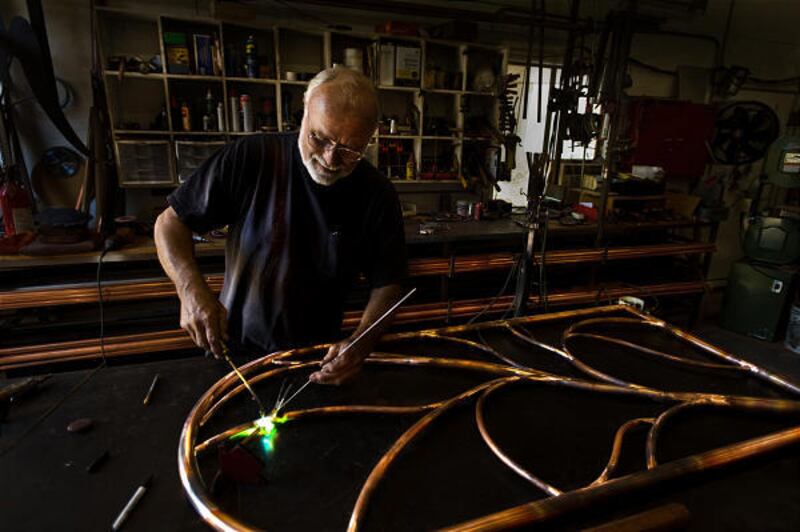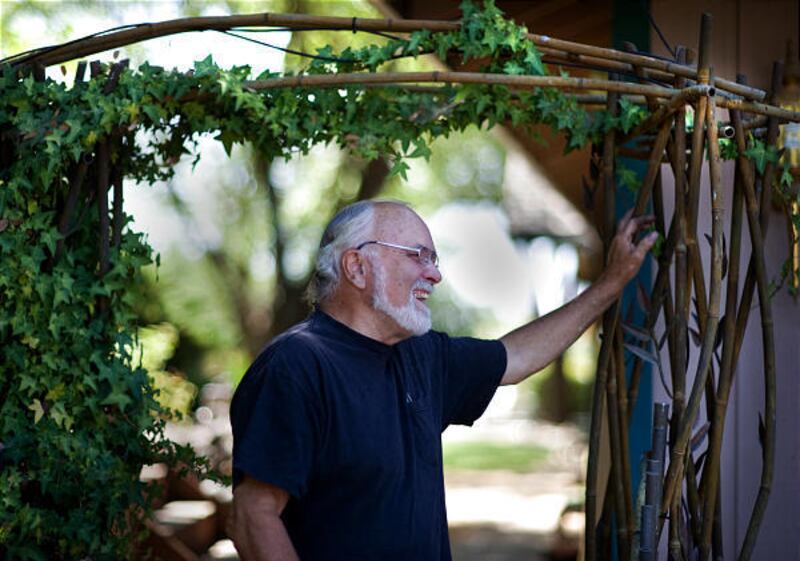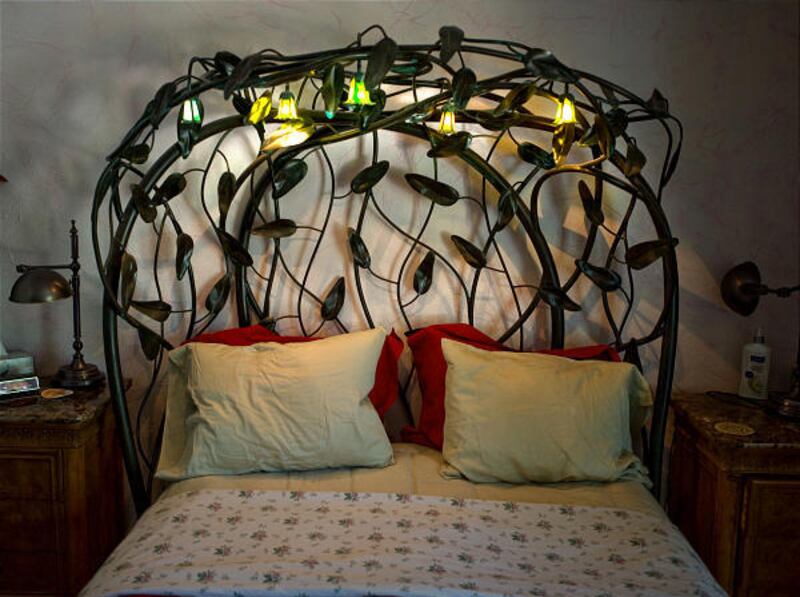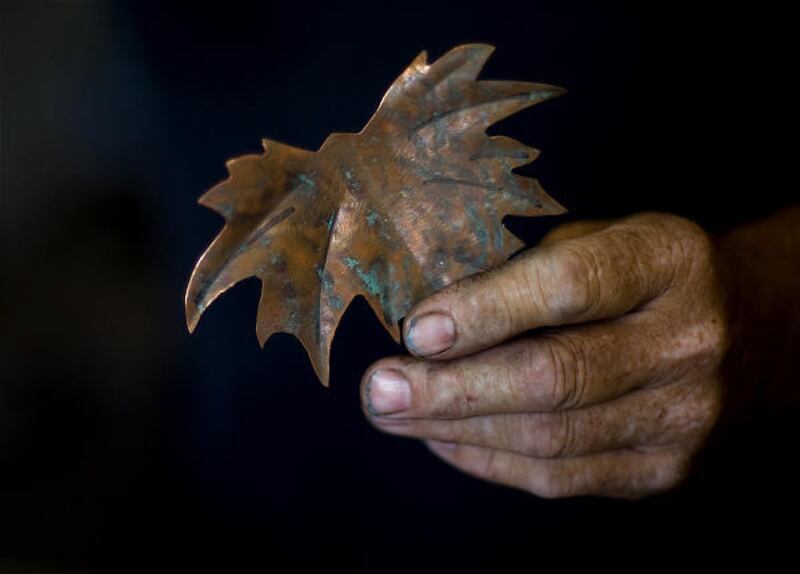SACRAMENTO, Calif. — In his tool-packed workshop in Rough and Ready, Calif., David Burns creates a copper forest that will never die.
Twisted vines and tropical leaves sprout out of shiny metal sheets. A customized pneumatic hammer transforms plain pipe into gnarled trunks.
With tin snips, Burns crafts delicate autumn leaves in luminous shades of coppery red and gold. He solders stalks of copper "bamboo" one node at a time, then hones and polishes each piece to perfection.
Burns' Copper Gardens grow out of his imagination, but his functional sculptures have taken root throughout Northern California.
His one-of-a-kind gates adorn homes and businesses. His tables and light fixtures stir constant conversation.
"Copper takes on a life of its own," he said. "It changes with time, but has this great lasting beauty.
"People want to touch it, to feel it, to connect," he added. "As an artist, that really tells me something."
Burns, 68, makes every piece to order. Among his recent pieces was a large driveway gate featuring stylized bamboo for the Marin County, Calif., home of rock singer-guitarist Bob Weir.
Burns' Copper Gardens displays draw crowds at major Northern California home shows. His work is a staple at the San Francisco Flower and Garden Show and was featured at this year's California State Flower and Garden Show in Sacramento. During Labor Day weekend, he'll be part of Truckee, Calif.'s Arts and Crafts Festival.
Kim and Stafford Matthews of Tiburon, Calif., first saw Burns' work several years ago at the San Francisco show.
"I've never seen anything like it," said Kim Matthews, who commissioned a bronze gate — Burns occasionally works in metals other than copper — for their home on San Francisco Bay. "He was so accommodating and dedicated. He's totally into it. And I can't tell you how many people stop by our front yard to admire the gate. It's absolutely fabulous."
Ursula Steele of Cameron Park, Calif., loved her Copper Gardens gate so much, she took it with her when she moved from Folsom, Calif.
Originally from Australia, she asked Burns to incorporate eucalyptus leaves and "the essence of a kangaroo" into the design. She no longer needed a gate for her new small patio in a retirement community, so she now uses Burns' work as outdoor art.
"He did a beautiful job," she said. "My gate was the envy of the neighborhood. Now, it's just sitting in my backyard, but it's still very attractive. The copper has aged beautifully."
A former race car driver, contractor and master woodworker, Burns turned to copper art after a personal epiphany.
About 15 years ago, he took a break from a massive wood deck project to accompany his wife, Annie, at the time a flight attendant, on a flight to Rome.
"I was sitting in front of the Pantheon, waiting for Annie to return from another flight," Burns said. "I was looking at this building that had lasted thousands of years. I realized that deck I was building back in California wouldn't even be recognizable in 50 to 100 years. I had always been a wood guy, but I decided I had to do something that would last."
He started experimenting with metals. A friend asked him to make a garden gate, and Burns became intrigued by copper.
"Everything about working with copper is weird and different," he said. "But the results can be unbelievable."
After some trial and error, he showed some copper garden gates and outdoor art at the Nevada County Fair in Grass Valley, Calif.
"I got 600 inquiries at that first fair," he said. "We had people standing six deep to see our booth. That's when I realized I had hit on something."
In his machine shop and studio, Burns works many hours each day.
"Once he gets started on a design, he goes at it," said Annie Burns. "He's out there seven days a week, from early morning into the night. I have to drag him out for dinner."
"He works very, very hard, but that's really acceptable to me," she added. "We're both creative people, and I understand that passion. When he's not working, he's thinking about designs, too. I would much rather have him doing something he loves than bitching about the office every night."
Burns occasionally teaches copper classes at his home in Rough and Ready, which has a 3,300-square-foot machine shop and a commanding view of California's Central Valley.
"Everybody wants to learn how to braze, to join the pieces. That's easy," he said. "It's the finish work that's hard. That takes a lot of time and continual practice. I'm always experimenting, coming up with better ways to do things."
He offered a maple leaf as an example, working the lobes and veins as he talked.
"The leaves are so complex," he said. "Each little edge, each indentation, needs to be worked and finished. You want it to look almost real, but not quite. You could spend an hour on a single leaf."
Often, scores of leaves will be part of a single gate. Reflecting the hours of work and high cost of copper (4-foot lengths of plumber's copper pipe and tubing cost $10 to $90, depending on diameter and thickness), the full-size gates start at $2,800. Large custom jobs range up to $40,000. Burns also makes small ornamental pieces such as light sconces or leaf accents, starting at about $250.
Copper pieces fill the Burnses' hillside home. He created a whimsical copper trellis and vine that frames their bed. Copper lamps and tables decorate the living room. A large glass yoke is cradled in a steel sculpture, one of his few departures from copper.
For the gates, every part is hand-fabricated by Burns, even the hidden hinges and locks.
"You can't buy copper parts like these," he said. "I have to do it myself."
Burns learned his metal skills and acquired a lot of his equipment during his sports car racing career, his longtime hobby.
"Many of the tools I used for fabricating parts for the race cars I now use (for the copper art)," he said.
Burns expects the demand for copper fixtures to increase, especially in public buildings.
"Copper naturally kills germs," he said. "It's great for handrails, for example, or any surface that gets touched. And it lasts forever."
Information: www.coppergardens.com or (530) 432-9598
COPPER CARE
Over time, copper develops a patina, a result of oxidation from exposure to air and moisture. That patina varies by climate.
In Sacramento, copper tends to turn pale blue-green. In the desert, it ages to dark brown. In the Bahamas, it becomes deep red.
Copper artist David Burns prefers not to lacquer his outdoor pieces so they can age gracefully and develop their own character.
Some people prefer copper's virgin color. To retain copper's bright, shiny look, experts recommend spraying on several thin coats of clear lacquer. That should preserve the bright shine without polishing. That method is not recommended for any items used with food.
To remove tarnish from copper, polish with salt or baking soda moistened with vinegar or lemon juice to make a paste. Apply with a soft cloth and circular motion. Don't use steel wool or abrasives.
After polishing decorative items, spray with lacquer to preserve the color, if desired.
"Bronze disease" — patches of corrosion — may attack copper, too. To remove, use hot vinegar or lemon juice mixed with salt or baking soda to form a paste. Apply that to the problem area and let sit for 15 minutes. Wash promptly with soap and water, rinse and dry thoroughly.
(c) 2010, The Sacramento Bee (Sacramento, Calif.). Visit The Sacramento Bee online at www.sacbee.com/. Distributed by McClatchy-Tribune Information Services.




